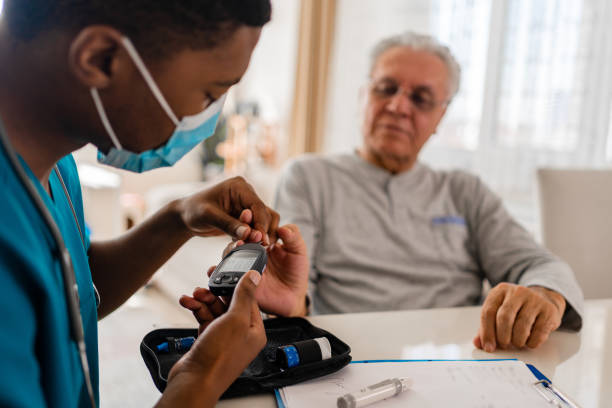Taking care of a diabetic patient at home requires proper management of their diet, medication, physical activity, and overall health monitoring. Whether it’s a family member or a loved one, ensuring their well-being can help prevent complications and improve their quality of life. Here’s a comprehensive guide on How to Take Care of a Diabetic Patient at Home effectively.

1. Understanding Diabetes
Before diving into home care strategies, it’s crucial to understand diabetes and its types.
Types of Diabetes
- Type 1 Diabetes – An autoimmune condition where the pancreas produces little to no insulin. Patients require insulin therapy for survival.
- Type 2 Diabetes – A condition where the body becomes resistant to insulin or does not produce enough. It can often be managed with diet, exercise, medication, and sometimes insulin.
- Gestational Diabetes – Occurs during pregnancy and usually resolves after childbirth, but it increases the risk of developing type 2 diabetes later.
- Prediabetes – A condition where blood sugar levels are higher than normal but not high enough to be classified as diabetes.
2. Essential Home Care Tips for Diabetic Patients
A. Blood Sugar Monitoring
Regular monitoring helps prevent complications and keeps diabetes under control.
How to Monitor Blood Sugar at Home
- Use a glucometer to check blood sugar levels.
- Maintain a log of daily readings to track patterns.
- Aim for a target blood sugar range (consult a doctor for personalized goals).
- Watch for symptoms of hypoglycemia (low blood sugar) and hyperglycemia (high blood sugar).
Recommended Blood Sugar Levels
| Time | Normal Range (mg/dL) | Diabetic Range (mg/dL) |
|---|---|---|
| Fasting | 70-100 | 80-130 |
| Post-meal (2 hrs) | <140 | <180 |
B. Medication Management
Diabetic patients often require medications or insulin to regulate blood sugar.
- Oral medications like metformin help control blood sugar.
- Insulin therapy may be needed for type 1 and some type 2 diabetics.
- Follow prescribed dosages and never skip medications.
- Store insulin properly in the refrigerator but not in the freezer.
C. Healthy Eating Plan
A well-balanced diet plays a crucial role in managing diabetes.
Best Foods for Diabetics
- High-fiber foods: Whole grains, lentils, vegetables.
- Lean proteins: Chicken, fish, tofu, beans.
- Healthy fats: Nuts, avocados, olive oil.
- Low-glycemic fruits: Apples, berries, pears.
Foods to Avoid
- Sugary foods: Cakes, pastries, sodas.
- Refined carbohydrates: White bread, pasta.
- Fried and processed foods: Chips, fast food.
D. Regular Physical Activity
Exercise improves insulin sensitivity and helps control blood sugar.
Recommended Activities
- Walking – 30 minutes a day, five times a week.
- Yoga – Helps reduce stress and improve metabolism.
- Strength training – Boosts muscle health and insulin efficiency.
Important: Always check blood sugar before and after exercise to prevent hypoglycemia.
3. Managing Diabetes-Related Complications
A. Preventing Hypoglycemia (Low Blood Sugar)
Symptoms: Sweating, dizziness, confusion, shakiness, hunger.
What to Do:
- Give 15g of fast-acting sugar (e.g., juice, glucose tablets).
- Wait 15 minutes and check blood sugar again.
- Repeat if necessary until levels stabilize.
B. Preventing Hyperglycemia (High Blood Sugar)
Symptoms: Increased thirst, frequent urination, fatigue, blurred vision.
What to Do:
- Drink plenty of water.
- Take prescribed medications or insulin.
- Engage in light physical activity (if not at risk for ketosis).
C. Diabetic Foot Care
Diabetics are at risk for foot infections and ulcers due to poor circulation.
Foot Care Tips
- Inspect feet daily for cuts, blisters, or wounds.
- Wash feet with warm water and moisturize, avoiding between toes.
- Wear comfortable, well-fitted shoes.
- Trim nails carefully to avoid ingrown toenails.
D. Managing Stress and Mental Health
Stress can raise blood sugar levels, so emotional well-being is essential.
Tips for Stress Management
- Practice deep breathing and meditation.
- Engage in hobbies and relaxing activities.
- Get enough sleep (7-9 hours per night).
- Seek support from family or support groups.
4. Emergency Preparedness for Diabetic Patients
A. Recognizing Signs of Diabetic Emergencies
1. Diabetic Ketoacidosis (DKA) – More Common in Type 1 Diabetes
- High blood sugar, nausea, vomiting, fruity-smelling breath.
- Emergency action: Seek medical help immediately.
2. Hyperosmolar Hyperglycemic State (HHS) – More Common in Type 2 Diabetes
- Severe dehydration, confusion, weakness.
- Emergency action: Drink fluids and go to the hospital.
B. Preparing an Emergency Kit
Keep an emergency diabetes kit at home with:
- Glucose tablets or juice (for low blood sugar).
- Insulin and syringes/pens.
- Backup glucometer and test strips.
- Doctor’s contact information.
5. Supporting a Diabetic Patient Emotionally
Living with diabetes can be overwhelming, and emotional support is crucial.
- Encourage a positive outlook and reassure them.
- Be involved in their care by attending doctor visits.
- Educate yourself about diabetes to offer better support.
6. Creating a Safe and Supportive Home Environment
A well-organized home plays a crucial role in how to take care of a diabetic patient at home effectively. Ensuring safety and accessibility can help prevent accidents and promote a stress-free living space.
A. Organizing Medications and Supplies
- Designate a specific area for diabetes medications, insulin, test strips, and syringes.
- Ensure all supplies are easily accessible and labeled.
- Keep an emergency contact list near the medications.
B. Preventing Accidents at Home
- Remove tripping hazards like loose rugs or clutter to avoid falls, especially for elderly diabetics.
- Ensure the kitchen is stocked with healthy food options to prevent unhealthy snacking.
- Use a blood sugar reminder app or set alarms to help with timely monitoring.
7. How to Take Care of a Diabetic Patient at Home with Special Conditions
Diabetes often coexists with other health issues. Here’s how to modify home care strategies for specific conditions.
A. Caring for Elderly Diabetic Patients
Elderly diabetics may have mobility issues and a higher risk of complications.
- Ensure easy access to restrooms to prevent accidents during frequent urination.
- Assist with medication reminders and blood sugar checks.
- Provide diabetes-friendly meals that are soft and easy to chew.
B. Caring for a Bedridden Diabetic Patient
Patients who are bedridden need extra precautions to prevent complications.
- Perform regular blood sugar checks to monitor fluctuations.
- Help with gentle movements or passive exercises to improve circulation.
- Check for bedsores and skin infections, especially on the back and feet.
8. How to Take Care of a Diabetic Patient at Home During Illness
Diabetes management becomes more challenging when a patient is sick. Illness can raise blood sugar levels, leading to complications.
A. Sick Day Guidelines for Diabetics
- Continue taking prescribed medications and insulin, even if appetite decreases.
- Monitor blood sugar every 3-4 hours.
- Stay hydrated with water, broth, and electrolyte drinks.
- Avoid sugary medications like cough syrups (opt for sugar-free versions).
- Contact a doctor if blood sugar remains above 250 mg/dL or if dehydration occurs.
9. How to Take Care of a Diabetic Patient at Home with Alternative Therapies
In addition to traditional medical care, some alternative treatments may help in managing diabetes symptoms.
A. Herbal and Natural Remedies
- Fenugreek seeds may help lower blood sugar.
- Bitter melon juice is believed to aid in glucose metabolism.
- Cinnamon may improve insulin sensitivity.
B. Acupressure and Massage Therapy
- Some studies suggest that acupressure and reflexology can improve blood circulation in diabetics.
- Gentle foot massages can enhance circulation and reduce nerve pain.
10. How to Take Care of a Diabetic Patient at Home by Educating Family Members
Diabetes management is a team effort, and family members should be well-informed about how to support their loved one.
A. Educating Family on Diabetes Management
- Teach family members how to check blood sugar levels.
- Ensure they know how to administer insulin safely.
- Explain the importance of dietary control and meal planning.
B. Preparing for Diabetic Emergencies
- Train family members on how to handle hypoglycemia and hyperglycemia.
- Keep emergency snacks, glucose tablets, and a first-aid kit handy.
- Ensure that all family members know the emergency contact numbers.
Conclusion – How to Take Care of a Diabetic Patient at Home
By following these comprehensive strategies on how to take care of a diabetic patient at home, you can create a safe, healthy, and supportive environment. Whether it’s through monitoring blood sugar, maintaining a balanced diet, ensuring proper medication use, or educating family members, proper diabetes management at home can significantly improve the patient’s quality of life.
Would you like a personalized diabetic meal plan or a customized exercise routine for your loved one? Let us know in the comments!

Heart 2 Heart: Providing Compassionate Home-Based Care for Diabetic Patients
At Heart 2 Heart, we understand the challenges of managing diabetes at home. Our expert caregivers provide personalized, compassionate, and professional home-based care to help diabetic patients live healthier, stress-free lives.
✅ Blood Sugar Monitoring & Medication Reminders
✅ Diabetes-Friendly Meal Preparation
✅ Foot Care & Preventive Health Checks
✅ Companion Care & Emotional Support
✅ Emergency Response & Lifestyle Management
Let us take care of your loved ones with the heartfelt care they deserve. 💙
📞 Call us today or Contact Us Schedule a Free Consultation
Heart 2 Heart – Because Every Heart Deserves the Best Care! ❤️

